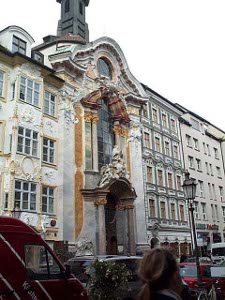 Medical exhibit
Medical exhibit
It's called the Deutsches Museum but it's really one of the first modern museums of science and technology, conceived in the nineteenth century, and finally completed in 1925.
 Medical exhibit
Medical exhibit
The museum curators recognize that nothing ages as rapidly as a science museum, and evidently they have the money to keep their exhibits up to date. Some of the displays were brand new and wonderful, such as the hair chemistry display sponsored by Wella and the medical exhibits showing the processing of gingko leaves, more anatomy and gene structure than we wanted to know, and a discussion of the most current health risks, including TB and AIDS. These newer exhibits were always bilingual, German and English, and highly interactive, with excellent films. Some of the displays, like chemistry, were closed, undergoing months of rework.
 Planes on display
Planes on display
It's a huge place, 164,000 square feet, and it would take days just to read all the captions. But there's plenty of room to absorb numerous school groups and still leave space for quieter tourists.
There are a lot of differences between a science and technology museum and a history of science and technology museum; the most important is that they attract different kinds of visitors. The Deutsches Museum is both. It has both modern and historical exhibits; predictably, the school kids were concentrated on the modern ones.
 Rocket exhibit
We were fascinated at the excellent depictions of the evolution of technological industries, including glass, ceramics, textiles, power, civil engineering (bridges and tunnels), railroads, aviation, optics, mensuration, machine tools, agriculture, even construction toys.
Rocket exhibit
We were fascinated at the excellent depictions of the evolution of technological industries, including glass, ceramics, textiles, power, civil engineering (bridges and tunnels), railroads, aviation, optics, mensuration, machine tools, agriculture, even construction toys.
Wandering through all the floors, we spent some time learning about paper-making in an exhibit which finished with the varied uses of paper including paper clothing. We saw printing presses and bookbinding equipment, heavy machinery, bicycles (including French and German military bikes which could be carried in a backpack and were apparently part of the equipment for specially equipped bicycle troops in the First World War), carriages and cars and trains and boats. And airplanes and rockets of all shapes and sizes and  Asamskirche
uses.
Asamskirche
uses.
One of our favorite rooms was bridge-building. Many different types of bridges were modeled, and we walked along a suspension bridge supported by cables strung from a pylon on the floor while watching models and videos of other bridge designs!
After a bored stroll through several rooms of ancient computer equipment (isn't it amazing that all the antiques in this field were made in our lifetimes, some of them rather recently!) we found the Math Cabinet, which had plenty of school kids enjoying the challenges of interactive exhibits of geometry and topology. There were lots of knots, tiling problems, orientation and connectivity for students to explore.
 Asamskirche interior
Asamskirche interior
Our only major disappointment were several silent galleries of musical instruments. We saw a glass harmonica, cembalo, bagpipe, and music box but couldn't hear them (we did hear a harpsichord being tuned). The museum is missing a chance to involve young people in a broader understanding of music and acoustics. Twice a day they do take some instruments out of the cases and play them, but they could be doing better here.
After another typical filling Bavarian lunch in the museum cafeteria, we wandered through more streets of Munich, past the Judaische Museum, which unfortunately won't be open until Sunday, after we have left for Hamburg, to the Asamskirche, where we saw the highest and gaudiest baroque church architecture yet! This is probably one of the few churches in the world named in honor of its architect. It is a small church but filled to the brim with multicolored marble, gold leaf, and plaster angels and saints.